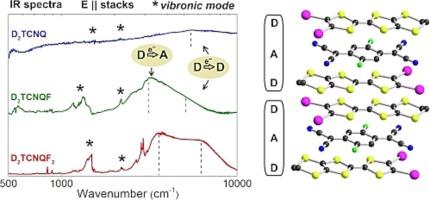三聚同位结构混合堆叠配合物(EDT-TTF-I2)2TCNQFn (n = 0,1,2)的电子-分子振动耦合。
IF 4.6
2区 化学
Q1 SPECTROSCOPY
Spectrochimica Acta Part A: Molecular and Biomolecular Spectroscopy
Pub Date : 2024-11-30
DOI:10.1016/j.saa.2024.125537
引用次数: 0
摘要
研究了三种同结构电荷转移配合物(EDT-TTF-I2)2TCNQFn (n = 0,1,2)的红外和拉曼光谱。这些配合物中的平面分子排列成一维堆叠,由供体-受体-供体(DAD)中心对称三聚体单元组成,它们在D和a之间具有不同程度的电荷转移。在红外电子能谱中可以区分出D→D和D→a两个电荷转移跃迁带。在红外振动光谱中,可以看到与D和A分子内振动与电子耦合有关的许多波段。在CN、CC拉伸和CH弯曲的受体模式以及CC拉伸的给体模式中,可以清楚地看到电子-分子振动耦合。这些模式作为温度(T = 300-10 K)的函数进行了研究。温度效应对于n = 1的配合物尤其显著,因为它经历了中性到离子的相变。在我们的研究中,我们发现电子-分子振动耦合对拉曼光谱也有影响。本文章由计算机程序翻译,如有差异,请以英文原文为准。

Electron–molecular vibration coupling in trimerized isostructural mixed-stack complexes (EDT-TTF-I2)2TCNQFn (n = 0, 1, 2)
Infrared and Raman spectra of three isostructural charge transfer complexes (EDT-TTF-I2)2TCNQFn (n = 0, 1, 2) are studied. The planar molecules in these complexes are arranged in one-dimensional stacks formed by donor–acceptor–donor (DAD) centrosymmetric trimeric units with a different degree of charge transfer between D and A. In the IR electronic spectra two bands attributed to D → D and D → A charge transfer transitions are distinguished. In the IR vibrational spectra, numerous bands related to coupling of D and A intramolecular vibrations with electrons, are seen. The electron–molecular vibration coupling is clearly seen for acceptor modes attributed to C![]() N, C
N, C![]() C stretching, and C
C stretching, and C![]() H bending as well as for C
H bending as well as for C![]() C stretching donor modes. These modes are investigated as a function of temperature (T = 300–10 K). The temperature effect is especially significant for the n = 1 complex which undergoes a neutral-to-ionic phase transition. In our study we show that the electron–molecular vibration coupling has also an influence on Raman spectra.
C stretching donor modes. These modes are investigated as a function of temperature (T = 300–10 K). The temperature effect is especially significant for the n = 1 complex which undergoes a neutral-to-ionic phase transition. In our study we show that the electron–molecular vibration coupling has also an influence on Raman spectra.
求助全文
通过发布文献求助,成功后即可免费获取论文全文。
去求助
来源期刊
CiteScore
8.40
自引率
11.40%
发文量
1364
审稿时长
40 days
期刊介绍:
Spectrochimica Acta, Part A: Molecular and Biomolecular Spectroscopy (SAA) is an interdisciplinary journal which spans from basic to applied aspects of optical spectroscopy in chemistry, medicine, biology, and materials science.
The journal publishes original scientific papers that feature high-quality spectroscopic data and analysis. From the broad range of optical spectroscopies, the emphasis is on electronic, vibrational or rotational spectra of molecules, rather than on spectroscopy based on magnetic moments.
Criteria for publication in SAA are novelty, uniqueness, and outstanding quality. Routine applications of spectroscopic techniques and computational methods are not appropriate.
Topics of particular interest of Spectrochimica Acta Part A include, but are not limited to:
Spectroscopy and dynamics of bioanalytical, biomedical, environmental, and atmospheric sciences,
Novel experimental techniques or instrumentation for molecular spectroscopy,
Novel theoretical and computational methods,
Novel applications in photochemistry and photobiology,
Novel interpretational approaches as well as advances in data analysis based on electronic or vibrational spectroscopy.

 求助内容:
求助内容: 应助结果提醒方式:
应助结果提醒方式:


